Menus
- Alone in the world
- Single cylinder VVA of 124 cm3, 15 hp and 11.5 Nm, 140 kg full made, 4,599 euros
- Discovery
- In the saddle
- In the city
- Motorway and expressways
- Departmental
- Braking
- Comfort and duo
- Consumption and autonomy
- The accessories
- The video test of the Yamaha XSR 125
- Conclusion
Alone in the world
Single cylinder VVA of 124 cm3, 15 hp and 11.5 Nm, 140 kg full made, 4,599 euros
Today, when you want to ride a vintage / retro / classic machine (cross out the unnecessary mention), you are spoiled for choice. Provided, of course, that you hold at least an A2 license. Below, it’s more complicated, the offer in this segment being almost exclusively made up of imports made in China. Be careful, I’m not denigrating, my iPhone also comes from there and the reliability of the machines of the Middle Empire sold here has made great progress under the pressure of the biggest European importers like KSR with the Brixton Rayburn. Besides, it pays, since vintage models now represent 13% of registrations of 125 in Europe. This is also true in France: the Mash Seventy, Orcal Astor have made a nice place in the sun, ranking respectively fifth and sixth in the Top 10 125 cm3 in 2020 … ahead of them? That scooters! Below? Stars like the KTM Duke 125 (7th), the Yamaha MT-125 (9th) and the Honda CB 125R (10th).
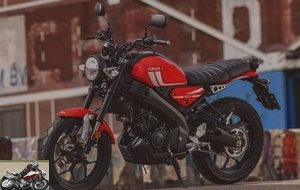 Test of the Yamaha XSR 125
Test of the Yamaha XSR 125
With this XSR 125, Yamaha is therefore the first “big” manufacturer to invest in this (juicy) segment (considering that the CB 125R is more neo than retro). And in all legitimacy given that its range already includes the XSR 900 and 700 in 2016.
Discovery
If you are a regular at Le Repaire, you already know that this 125 is not really new. An XSR 155 already exists on the Thai market since early 2020 and the engine chassis assembly is common to the MT 125 and YZF-R125. The technical data are also very close to that of the MT with a wheelbase 1330 mm (+ 5 mm), an identical weight of 140 kg in running order, the same identical flush angle, an 11-liter tank ( + 1 liter), a saddle height of 815 mm (+ 5 mm)…
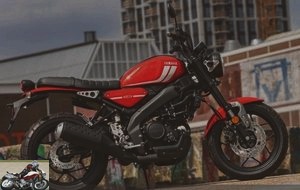 The classic XSR range is now available for A1 licenses
The classic XSR range is now available for A1 licenses
Aesthetically, however, the tuning forks brand has gone all out and except for the Deltabox frame, it has nothing to do with the little manga-esque roadster and the sporty microphone. Personally, I even find that the design is much more successful than that of its big sisters 700 and 900 with a profile clearly underlined by a horizontal line materialized by the base of the saddle and the tank, typical of productions of the 60s and 70s. Large handlebars and wide tread tires finish off giving the XSR 125 a mini scrambler look. A few modern touches remain here and there: the round headlight at the front and the brake light at the rear use LEDs and the dashboard has a white LCD display on a black background..
 The XSR is fitted with IRC Trail Winner GP-211R tires
The XSR is fitted with IRC Trail Winner GP-211R tires
On paper, the VVA engine does not change with an unchanged output of 15 hp (European limit) and 11.5 Nm. However, the engine was entitled to a whole set of improvements with the transition to the Euro5 standard: the ducts intake as well as the airbox have been reworked, the injection recalibrated, the profile of the cams revised, the cooling of the liners optimized, the diameter of the exhaust valve is reduced by 1 mm and the exhaust now incorporates a double catalyst.
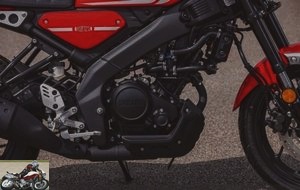 The XSR opts for the single cylinder VVA of 125 cm3
The XSR opts for the single cylinder VVA of 125 cm3
At the front we find an inverted fork 37 mm in diameter coupled to a braking system a little more modest than on the MT 125 (see braking section). Overall, the general size is more imposing than the Chinese competition, the XSR 125 is more “big bike” without the toad-buffalo side of the old Honda Varadero 125.
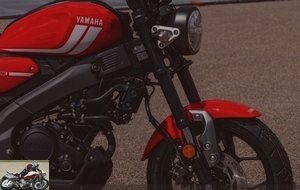 The inverted fork of the Yamaha XSR 125
The inverted fork of the Yamaha XSR 125
In the saddle
Looking at the XSR, we notice that the finish is to Japanese standards and rather in the very top of the basket for a 125. The 815 mm saddle is easily spanned and once on it, we have the feet almost flat from 1.70 m. If we remain in the comparison with the MT, the driving position has been revised (see comfort and duo section) to accommodate all types of templates.
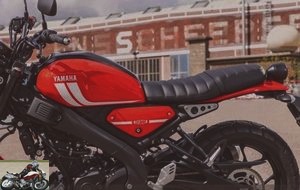 The saddle peaks here at 815 mm
The saddle peaks here at 815 mm
The controls fall easily to hands and the board is ultra readable in all light conditions. Little more, left-handed and right-handed are housed in the same sign to scroll through the information of the round meter (two trips, consumption, etc.) since there are two control buttons, one on each side. The mirrors? Not bad, but not wide enough that they mirror the entire road behind, 10% of the surface will be occupied by your biceps. More if you are muscular. Too bad, however, that the front brake is not adjustable in spacing, small hands will have a little trouble putting their four fingers on the lever. Press the starter and the XSR snorts discreetly. Hop, it’s time to discover the XSR 125 in the streets of Amsterdam.
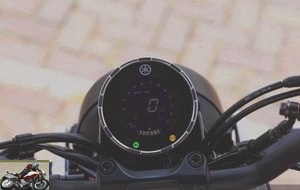 The speedometer of the Yamaha XSR 125
The speedometer of the Yamaha XSR 125
In the city
According to one of my colleagues, who drives the Yamaha engine on a daily basis, the switch to Euro5 standards has substantially improved the comfort of the block. Formerly hollow like a radish under the bar of 7,400 rpm, the fateful bar where the most aggressive camshaft comes into action, the VVA variable distribution block now offers a substantial gain in torque from 5,000 rpm. It is also on this diet that we naturally settle into cruising mode. If you are lazy on the left ankle, you can obviously ride under this regime, the mono – very flexible – accepts the thing perfectly. But don’t push the plug too far either. If the XSR agrees to evolve at 2,000 revolutions in sixth (30 km / h), the single cylinder clearly shows you that it does not like this kind of treatment: it slams, it vibrates and even when wringing the handle, you will probably be dropped off when accelerating by an asthmatic octogenarian on a velib ‘.
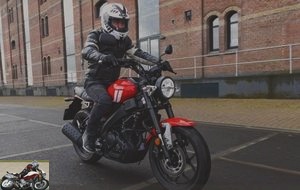 Test of the Yamaha XSR 125 in the city
Test of the Yamaha XSR 125 in the city
Do you really want coziness? Buy a scooter. But as long as you stay in the optimum range of use (from 5 to 11,200 rpm, therefore, that’s wide), all is well. The first three reports are short staged and make it possible to take full advantage of the 15 hp of the single cylinder. The thrust is frank up to 10,500 rev / min before regulating quietly until the entry into action of the regulator at 11,200 revolutions. The clutch is so flexible that you can operate it with a finger and the gearbox does its job properly. The setting on the angle is done without forcing thanks to the large handlebars and the light weight of the unit and the round profile of the IRC tires exacerbates the natural handling of the unit. And if necessary, the U-turns are done around a one euro coin.
 The Yamaha XSR 125 in town
The Yamaha XSR 125 in town
Motorway and expressways
If the Yamaha engine deposits on the first three reports, the thrust is watered down considerably in fourth and fifth. The sixth, it almost acts as an overdrive to lower fuel consumption and it will be necessary to revert to the first false flat or as soon as you have the wind head on. The XSR will take you quickly up to 100 km / h. To reach the Vmax on the other hand, it will take a little patience. With room, our barely run-in test models touched or slightly exceeded the 120 km / h mark and no doubt that once well run-in, they will easily spin at (a little) over 130 km / h. At these speeds, nothing to report on the chassis side, nothing moves, even in large curves.
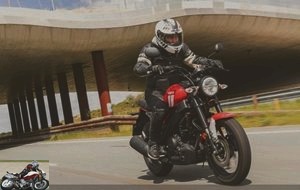 Test of the Yamaha XSR 125 on the fast track
Test of the Yamaha XSR 125 on the fast track
Departmental
Ha, the joys of driving a 125. To have fun, an eighth of a liter has to be whipped. The XSR is no exception to the rule and to take full advantage of the 15 hp you have to stay above 7,500 rpm. And the XSR lets itself be martyred without a second thought, since the chassis is sized to handle double the power. It’s healthy, rigid and the suspensions offer all the necessary rigor (in the absence of comfort) in this exercise. Brakes and tires too (phew). No pumping on the horizon, artistic blur on bumps or other pranks like that, but if you like sports or 90% of your trips are on this type of road, I recommend an MT 125 instead, well better braking machine. In ballad mode, the Euro 5 block here also displays all the pleasure of its “new” torque at mid-speed.
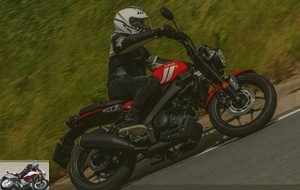 Test of the Yamaha XSR 125 on the road
Test of the Yamaha XSR 125 on the road
Braking
The braking system differs from that found on the MT 125. The roadster had the right to heavy with a radial fixed caliper pinching a disc 292 mm in diameter. The XSR is satisfied with a floating caliper with two pistons mounted in parallel and a 267mm disc. Suddenly the power and bite are less which should reassure beginners. The assembly is sufficiently powerful for the level of performance of the machine, except for the first kilometers when the disc and pads are cold. Same remark for the IRC TrailWinner wide tread tires, not very efficient in cold conditions (and a tad long to heat up), but flawless once warmed up..
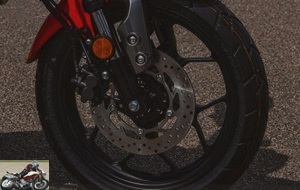 The front brake of the Yamaha XSR 125
The front brake of the Yamaha XSR 125
Comfort and duo
Overall, the comfort is neither good nor bad, but a few irritating details should be noted, especially for small sizes. The more loose position than on the MT (driver’s seat set back and handlebars higher) will force the shorter legs – of which I am part – to ride with the crotch glued to the tank. The problem is that the lower edges of the saddle compress the groin and end up stiffening the legs on long journeys. Put everything in order by moving back on the seat, but if you are more than 170 cm, you will not have this luxury since your arms will be almost stretched out to the maximum. Check before signing a purchase order … Another complaint, the rear shock absorber filters the successions of small shocks quite badly (Parisian cobblestones or, in our case, Dutch bricks), the fault of a hydraulic system that is a little too firm in compression. Too bad, because the fork fulfills its function perfectly under the same conditions. Finally, note that the foam square dedicated to the sandbag is much wider and more welcoming than on the MT 125 and that the footrests are anchored lower. Good point for the passenger therefore.
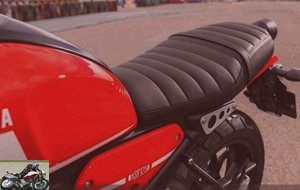 The saddle of the Yamaha XSR 125
The saddle of the Yamaha XSR 125
Consumption and autonomy
Normalized consumption is announced for 2.1 l / 100 km. On our test route, which was very varied, our average stabilized at around 2.4 liters with occasional peaks of 2.8 liters in town and on very fast sections. Combined with the 11 liters of the tank (one more than on the MT), this therefore suggests a range of between 390 and 460 km.
The accessories
Fanatic individualists, rejoice, Yamaha has planned two packs and a whole bunch of accessories to recognize at first glance its XSR in front of your favorite bar terrace. The Racer pack (515 €) includes a fork crown, side tank guards, specific side covers and a “slim” license plate holder. The Street pack includes a small screen, the same license plate holder as the Racer pack, engine guards and side covers for the engine guard and the radiator. All these accessories – and others like a headlight lens cover or mini LED turn signals – are available individually and the inevitable Akrapovic exhaust will join all these little people in September..
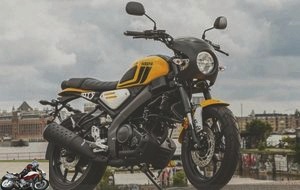 The XSR 125 equipped with the Racer accessory pack
The XSR 125 equipped with the Racer accessory pack
The video test of the Yamaha XSR 125
Conclusion
During the presentation of the XSR 125, Yamaha (supporting figures) did not fail to point out that Vintage is no longer a fad, but a full segment of the motorcycle industry. And it is growing every year more. And against all odds, the health crisis has had beneficial effects on the small-engine market. Between compulsory social distancing and a certain fear of promiscuity, many people come or return to two wheels for their daily trips. And the upcoming review of the small-cylinder license on a European scale should further accentuate this phenomenon. Yamaha, as the only big manufacturer in this segment, therefore has a small avenue ahead of it to win in this segment with the XSR 125. Pretty, healthy and sober, it has all the cards in hand to win. At least until the other Japanese get out of the machines capable of replying to him…
 The Yamaha XSR 125 is available in three colors
The Yamaha XSR 125 is available in three colors
Price side, the price of the XSR 125 is fixed at 4,599 €, against 5,199 € for the MT 125 and 5,499 € for the R 125. Three colors will be available at launch in early July: red / white, yellow black and a black / gray / red a little too discreet. And as is very often the case with Yamaha, the price should increase in case of success (yes, it’s you I’m watching MT 125!). The XSR 125 is it a direct competitor of Mash, Orcal and other Bullit? Difficult to say, the price delta is such (almost double) that they are almost two different products, but for first-time buyers, the reputation of Yamaha, the quality of finish of the XSR and the robustness of the distribution network of the Japanese should allow it to easily recover the title of best selling motorcycle 125 in France.
Strong points
- Euro5 engine approval and performance
- Aesthetics and finish
- The price placed (for a Yamaha)
- Handling
Weak points
- Saddle comfort for small riders
- rear suspension too stiff on small shocks
The technical sheet of the Yamaha XSR 125
Test conditions
- Route: 140 km in Amsterdam and its surroundings, extremely varied route, both in terms of the profile of the road and the quality of the asphalt
- Motorcycle mileage: 340 km
- Problem encountered: RAS
Related articles
-
Light is Right ! The little Duke 390 is an amazing machine. Ultra light and very powerful without being radical, it comes to hunt on the lands of the…
-
Harley-Davidson Forty-Eight and A2 test
1202 cm3, approx. 60 horsepower at 5500 rpm, 96 Nm at 3500 rpm, 252 kilos with full tank, from 12,410 € A minimalist and very stylish machine, generous…
-
Yamaha Tracer 700 GT motorcycle test
Joys of possibilities Twin-cylinder in-line, 689 cm3, 74.8 hp, 68 Nm, 200 kg all full, available in A2, 8,999 euros. The Yamaha Tracer 700 Gt! Here is a…
-
3 cylinders, 847 cm3, 115 hp, 8.9 m / kg, 195 kilos, € 12,599 A limited series of 695 pieces in collaboration with Abarth October 2007: Valentino Rossi…
-
Upgrading Unchanged since 2012, the Yamaha 450 WRF has this time been completely revisited. Derived from the excellent YZF cross model, this new Yamaha…
-
2015 vintage Thirteen years since the TMax made its appearance with several major evolutions since the TMax 500 cm3. If the maxi scooter evolves again in…
-
Yamaha Fazer 1000 motorcycle test
Arrival in France at the beginning of the year 2001, the big sister of the FZS 600 Fazer is available at dealers since March. Three months later, she…
-
The two top-of-the-range versions of the Tmax are rich in electronics and comfort and safety equipment In-line twin, 46 hp, 53 Nm, traction control,…
-
Suzuki GSX-R 600 motorcycle test
Little Queen Revamped this year, the 600 GSXR follows in the footsteps of its big sister 750 cm3 from which it borrows the dress and even all the…
-
Honda Varadero 1000 XLV motorcycle test
Maxi-Trail with a road vocation The Honda XL 1000 V Varadero, which appeared in 1998, is the heir to the famous Africa Twin … but the manufacturer has…
Hello everyone
Well this machine is great but too expensive to buy and even more for maintenance I have a 400 but I have problems 1 brake hose has come loose in the factory 10 days to have a leak motor crankcase gasket still defective not resolved now injector starting problem always changed the problem 4 weeks of immobilization to this day still not my motorcycle namely it has 2150 km phew
Hello everyone
I don’t understand what this convertible is doing on this site. This is "the den of scooters" here ??? It’s big, heavy, expensive and there is no CV, it’s not a motorbike, yuck … I’m going to throw up.
I think there are other sites to show this sort of thing …
Hello
there are people who should learn politeness this for qooder 4 it is good to know that there are more and more if I understand the gugus below the french and italian gendarmerie they are idiot, you have to live with his century look at the new motorbikes you are a workhorse that you need.
The price makes you cough especially for an unfortunate 30 hp engine.
Out of the question to go on the road with that, a beautiful loaded baby and he no longer holds the 130.
Not to mention the coasts …
A 4-wheel vehicle accessible with the B license is not so much what you might call a motorcycle. A competitor for the twingo, I suppose but the twingo is still ahead in all respects (lower price, engine, seats, roof, loading capacity, comfort, radio cd, air conditioning optional …).
Well, in any case, besides curiosity, I don’t think it will be of much interest to the A licenses..
V
Ridiculous …. four wheelbarrow wheels one mono and the value of three plastic cups for the dressing = 12,500 €. ??? This is the first prize for a good car. Traffic jams still have a bright future ahead of them.
Clearly, there will be a spectacle: the first attempt at fun on the road with a leek on the handlebars has the greatest chance of ending in a straight line.
Lacks a roof and diesel to reinvent the "boitaroue"
It looks nice this scooter … but I would have appreciated being able to read your last Tmax test..
The evolution between the 500 and the 530 is real according to many, but your opinion counts more 🙂